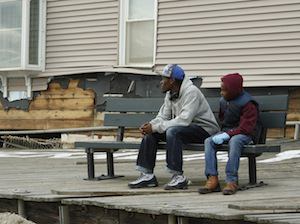Down and Out at Rockaway Beach
Life lurched back into motion as power was restored to all but 5,800 Manhattan residences and businesses over the weekend. But prospects for a return to normalcy after Hurricane Sandy remained dim for some 130,000 people who call the Rockaways home.Prospects for a return to normalcy after Hurricane Sandy remain dim for some 130,000 people who call the Rockaways home.
NEW YORK CITY — Life lurched back into motion as power was restored to all but 5,800 Manhattan residences and businesses over the weekend. But prospects for a return to normalcy after Hurricane Sandy remained dim for many in the Rockaways, a peninsula community in the southernmost area of New York City that is part of Queens but that juts into the Atlantic facing the open sea. The peninsula took one of the worst poundings from the storm.
The Rockaways are home to roughly 130,000 people, many of whom live in tall public housing complexes that line a stretch of land only a few city blocks wide. Subway service on the A line had yet to be restored, so I took a series of shuttle buses from the Broadway Junction stop in Brooklyn down to Rockaway Beach. Traffic ground to a halt in the Jamaica Bay community of Broad Channel, where passengers had ample time to gape at large and growing piles of debris outside homes while police officers ushered cars around large boats marooned in the road when the storm waters that had inundated the area receded. Residents of one home took the defense of what remained of their belongings seriously. A warning, “Looters will be crucified – God help you,” was scrawled on a sheet of plywood that was leaning against an open garage.
This was my first time on the peninsula, so I didn’t have a good idea of where I was going. After leaving the bus, I walked toward the ocean and what seemed to be a residential neighborhood. I spotted a man in his mid-20s with a beard, a dark cap, mud-splattered clothes and a utility belt. He was pushing a bicycle along a sidewalk, which was strewn with loose electrical and telephone cables. I guessed that he was part of the relief effort. When I caught up with him, he told me I was heading toward the volunteer site for the Rockaway Beach neighborhood. I turned down a residential street piled high with more of the kind of debris I had seen in Broad Channel. Two men in jeans and dirty sweatshirts labored to haul a washing machine onto a sidewalk.
After a ways, the street opened up to what was functioning, in the aftermath of the hurricane, as a town square. I walked past the NYPD’s 100th Precinct, where a number of officers on break were sipping coffee supplied by a truck loaded with refreshments and snacks. Just beyond, a vast parking lot situated between a large apartment building and a row of homes and businesses was teeming with people. A thick layer of sand covering the pavement was being kicked around by hundreds of people poring over scattered heaps of clothes and nonperishable food. Others crowded around generators, charging their cellphones and laptop computers as they endured a series of muffled explosive sounds emitted by the machines.
At the edge of this human jumble were a number of tables serving hot food. As I browsed the offerings, a man in a turban handed me a Styrofoam plate loaded with rice, beans and vegetable biryani.
With food in hand, I returned to the crowd. The place had the energy of an open-air market. People moved with determination to get the supplies or help they needed, but there was no sense of panic. Moving further into the parking lot, I came across cars that had been picked up and smashed against one another in the storm surge and flooding. Just beyond them were huge machines pushing all manner of debris into what were becoming small mountains.
I eventually came to a beach. Had I arrived a few days earlier, I would have been looking at a famous boardwalk. Now I was staring at the concrete pylons that remained and a string of merchant and military vessels bobbing on the horizon. Wondering where the wooden walkway had gone, I looked around. An intact section measuring a block wide was resting against a house, its wooden benches still bolted in place. Planks that had splintered off were among the debris being gathered in the parking lot. Huge chunks of the shattered boardwalk were clogging a street and in some sections covered the road entirely. Children played on them as their parents and others hauled more debris out into the road. Tattered American flags fluttered from the porches of most of the surviving homes on the block.
Having finished my food, I began what would be rightly called an absurd search for a garbage can. After walking a ways down the street, a woman wearing gloves and a machinist’s apron nodded that I could throw the leftovers onto a trashpile in front of her home.
I spent another half an hour wandering around. There were computers, record collections, jewelry boxes and sofas — everything people owned that was caught at ground level at the time of the flood. Many residents didn’t heed the warnings to evacuate ahead of Sandy because when they fled last year during Hurricane Irene, the promised destruction never came.
I came across more people serving food. Church groups and local restaurants led these efforts. The people looked dirty and tired, but they soldiered on. They simply carried whatever needed to be carried and offered crackers and bowls of soup to anyone who passed by.Two thoughts struck me as I considered what I saw. First, anyone who says that people who lack money are lazy should be required to make the claim at loud volume amid a relief effort in a low-income community like this one. Second, the disaster movies that dominate Hollywood are written by people who have never had such an experience. They tell stories they know will appeal to audiences of people who delight in imagining themselves as survivors of a worldwide catastrophe. There was no such delight here in Rockaway.
After picking my way through the neighborhood, I found a generator-powered bookmobile outside a Queens Public Library building. My cellphone was nearly dead, so I walked in to get a charge. Inside were half a dozen neighborhood residents. Some were reading; others were just getting out of the cold. One man studied a biography of Barack Obama. Two women, a man in his late 20s and a young girl sat quietly nearby. I introduced myself and asked how they had endured the storm.
“Everything in my basement” was lost, the girl said.
When I asked if everything above ground was OK, she explained that the basement was her home.
The man who had been reading overhead my questions.
“You from the neighborhood?” he asked.
“No,” I said. “North Brooklyn.”
“Most of Brooklyn was pretty lucky,” he responded.
“Yeah,” I said. “Did you lose everything, too?”
“I got my place, but nothing that was in it. It’s cold too, but there’s nothing I can do about that. It’s a night to be under a woman, let me tell you. But I don’t even have that.”
He said his name was Jervais. He anticipated waiting a long time for electricity to be restored to the neighborhood and thought city and federal officials didn’t care enough to give the Rockaways the urgent attention it needed. A woman standing at the back of the bookmobile disagreed. She was an employee of the library, dressed in clothes she had bought the day before because everything she owned had been washed away.
“I have my health,” she said. “That’s all I need.”
FEMA, Con Edison and the NYPD were doing everything they could, she declared. But Jervais wasn’t buying it. The conversation eventually turned to the looting that had taken place immediately after the storm.
“There’s lots of kids in the Rockaways with brand new sneakers,” Jervais said.
Most of the storefronts I had seen on the way in and through the Rockaways were smashed in or boarded up. Many bore graffiti that said everything inside had been taken.
It was getting dark outside. One of the women in the bookmobile warned me that buses into town would stop running at 6 p.m. It was already 4:30. A lot of volunteer workers and others would be looking to get back home. I unplugged my phone, thanked the library employee and walked outside.
Two buses showed up within the next hour. I passed on the first one, which was crowded with riders, and boarded the second one. On the long ride home, two men and a woman spoke loudly and endlessly about everything they had lost and the kind of civil disobedience it might take to get the electricity turned back on in a timely manner.
“Anyone who pays rent in the Rockaways is crazy,” one man huffed.
Others stared silently out the windows or tried to sleep. The bus made its way back toward the city center, navigating through the flotsam of battered boats and debris still cluttering the road.
Your support matters…Independent journalism is under threat and overshadowed by heavily funded mainstream media.
You can help level the playing field. Become a member.
Your tax-deductible contribution keeps us digging beneath the headlines to give you thought-provoking, investigative reporting and analysis that unearths what's really happening- without compromise.
Give today to support our courageous, independent journalists.






You need to be a supporter to comment.
There are currently no responses to this article.
Be the first to respond.